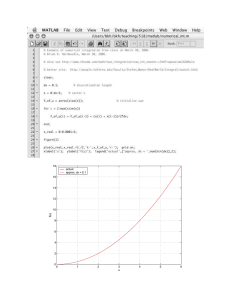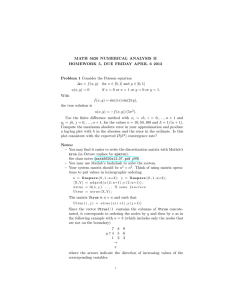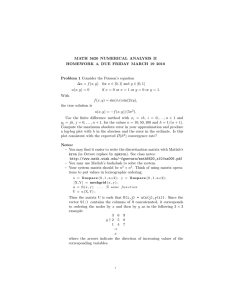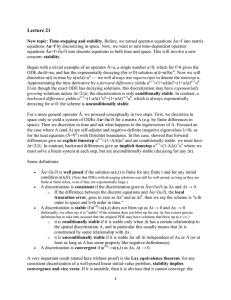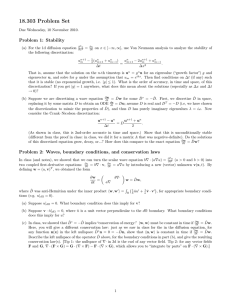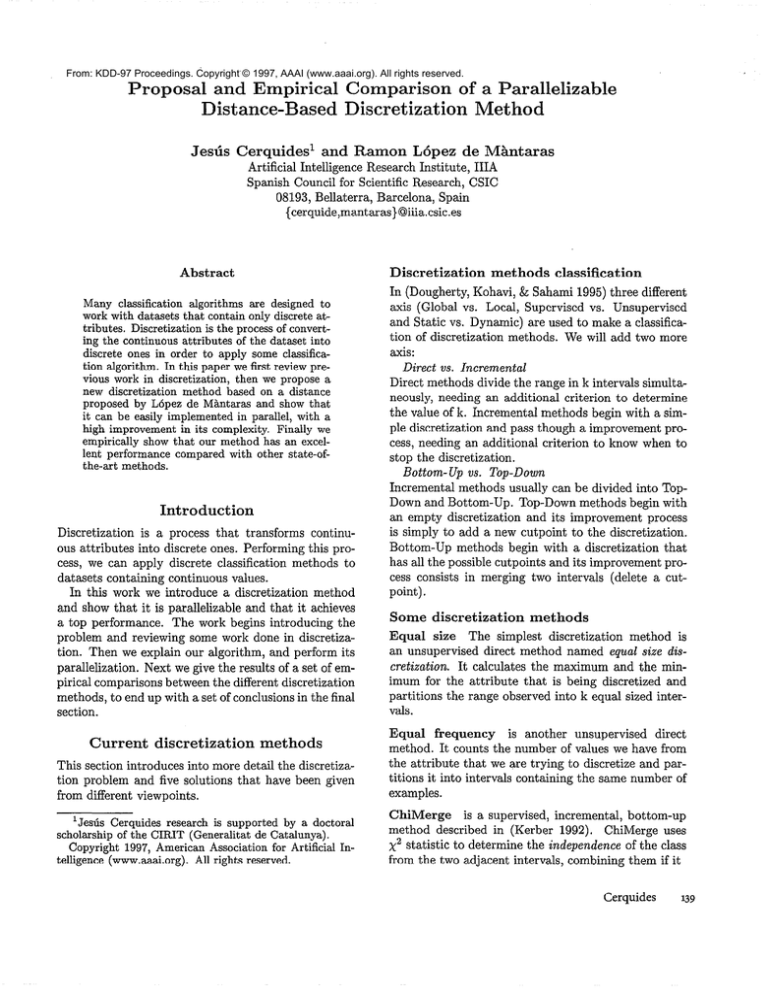
From: KDD-97 Proceedings. Copyright © 1997, AAAI (www.aaai.org). All rights reserved.
Proposal and Empirical Comparison of a Parallelizable
Distance-Based Discretization Method
Jestis Cerquides’
and Ramon
Ldpez de MBntaras
Artificial Intelligence Research Institute, IIIA
Spanish Council for Scientific Research, CSIC
08193, Bellaterra, Barcelona, Spain
{cerquide,mantaras}@iiia.csic.es
Abstract
Discretisation methods classification
Many classification algorithms are designed to
work with datasets that contain onIy discrete attributes. Discretization is the process of converting the continuous attributes of the dataset into
discrete ones in order to apply some classification algorithm. In this paper we first review previous work in discretization, then we propose a
new discretization
method based on a distance
proposed by LBpez de MSntaras and show that
it can be easily implemented in parallel, with a
high improvement in its complexity. Finally we
empirically show that our method has an excellent performance compared with other state-ofthe-art methods.
Introduction
Discretization is a process that transforms continuous attributes into discrete ones. Performing this process, we can apply discrete classification methods to
datasets containing continuous values.
In this work we introduce a discretization method
and show that it is parallelizable and that it achieves
a top performance. The work begins introducing the
problem and reviewing some work done in discretization. Then we explain our algorithm, and perform its
parallelization. Next we give the results of a set of empirical comparisons between the different discretization
methods, to end up with a set of conclusions in the final
section.
Current
discretization
methods
This section introduces into more detail the discretization problem and five solutions that have been given
from different viewpoints.
‘Jestis Cerquides research is supported by a doctoral
scholarship of the CIFUT (Generalitat de Catalunya).
Copyright 1997, American Association for Artificial Intelligence (www.aaai.org). All rights reserved.
In (Dougherty, Kohavi, & Sahami 1995) three different
axis (Global vs. Local, Supervised vs. Unsupervised
and Static vs. Dynamic) are used to make a classification of discretization methods. We will add two more
axis:
Direct vs. Incremental
Direct methods divide the range in k intervals simultaneously, needing an additional criterion to determine
the value of k. Incremental methods begin with a simple discretization and pass though a improvement process, needing an additional criterion to know when to
stop the discretization.
Bottom-Up vs. Top-Down
Incremental methods usually can be divided into TopDown and Bottom-Up. Top-Down methods begin with
an empty discretization and its improvement process
is simply to add a new cutpoint to the discretization.
Bottom-Up methods begin with a discretization that
has all the possible cutpoints and its improvement process consists in merging two intervals (delete a cutpoint).
Some discretixation methods
Equal size The simplest discretization method is
an unsupervised direct method named equal size discretization. It calculates the maximum and the minimum for the attribute that is being discretized and
partitions the range observed into k equal sized intervals.
Equal frequency
is another unsupervised direct
method. It counts the number of values we have from
the attribute that we are trying to discretize and partitions it into intervals containing the same number of
examples.
ChiMerge
is a supervised, incremental, bottom-up
method described in (Kerber 1992). ChiMerge uses
x2 statistic to determine the independence of the class
from the two adjacent intervals, combining them if it
Cerquides
139
is independent, and allowing them to be separate otherwise.
Entropy is a supervised, incremental, top-down method described in (Fayyad & Irani 1992),(Fayyad &
Irani 1993). Entropy discretization recursively selects
the cutpoints minimizing entropy until a stopping criterion based on the Minimum Description Length criterion ends the recursion.
D-2 is a supervised, incremental, top-down method
described in (Catlett 1991). D-2 recursively selects the
cutpoints maximizing Quinlan’s Gain until a stopping
criterion based on a set of heuristic rules ends the recursion.
Distance-Based
discretization
Our algorithm, based on Mantaras distance between
partitions (Lopez de Mantaras 1991), is global, supervised, static and Top-Down incremental. This means
that it is required to have two main components, a cutpoint selection criterion and a stopping criterion. Once
the examples have been sorted by the attribute value,
the main loop of our implementation of the method is:
function MDiscretization(Set S,Attribute A)
Discretieation = 0
NewCutPoint = SelectNewCutPoint(S,A,Discretization)
While (ImprovesDiscretization(S,A,Discretization,NewCutPoint))
Discretization = Discretization U {NewCutPoint)
NewCutPoint = SelectNewCutPoint(S,A,Discretization)
return Discretization
Our algorithm is iterative, considering the whole set
for the selection of each new cutpoint, while previously
seen Top-Down incremental methods were recursive divide and conquer algorithms.
Cutpoint selection criterion
In the ID3 algorithm, we estimate the classification
power of an attribute by some measure (Gain, Gain
Ratio, 1 - Distance,...). We want to generate a set of
cutpoints so that the classification power of the resulting discretized attribute is the highest possible. Our
idea is to follow a greedy heuristic in this search.
Each discretization can be identified with a set of
cutpoints. We denote by PO the partition induced by
a discretization D. We will note PD”{TJ the partition
induced in our dataset when the discretization applied
to our attribute is the result of adding cutpoint T to
the discretization D. In these terms the requirement
is to find a cutpoint TA so that it accomplishes:
normalized Distance which is defined as:
Dist(Pc,
PO) =
140
KDD-97
VC
+ I(pDIpC)
n PD)
(2)
where I(PcIPD),I(Pc
n Po),I(PD) are the standard
Shannon measures of information.
For more details
see (Lopez de Mantaras 1991).
Once TA is found, the next step is checking whether
the cutpoint improvement is significant enough to accept it or if otherwise no further cutpoints are considered necessary for the discretization.
The stopping criterion
We needed a heuristic to evaluate improvement. We
developed a stopping criterion based on the Minimum
Description Length Principle (MDLP).
The development followed to apply MDLP to our
problem is parallel to that in (Fayyad & Irani 1993).
The problem that needs to be solved is a communication problem. We have to communicate a classifier
method, that allows the receiver to determine the class
of each example. The sender knows all the attributes
of the examples, plus the class, and the receiver knows
all the attributes of the examples but not the class.
The sender must choose the shortest description for
sending a message that allows the receiver to correctly
classify each example.
The encoding length of communicating the set of
classes based on a p-cutpoint discretization can be decomposed as Len(Disc) I- Len(CZasseslDisc)
. If we
note N the number of examples of the dataset, Ic the
number of classes, ,%ithe number of classes in the interval i of the discretization, Si the set of examples in
the same interval and Ent(S) Shannon Entropy for the
set S, we have:
Len(Disc)
= p Zog(N - 1) + (p f 1)t + 2
ki.Z3nt(Si)
i=o
Len(Classes\Disc)
= 2 ISilEnt
id
Given two discretizations, one with p and the other
with p+i cutpoints, we will choose that with the minimal length. If it is the one with p cutpoints, then we
stop our algorithm and no more cutpoints are added
to the discretization, otherwise we consider including
another cutpoint.
Computational
Where PC is the partition generated in the dataset
by the class attribute and Dist stands for Mantaras
J(pClpD>
complexity
The computational complexity of the method is not
easily measurable, because the stopping criterion depends on the data in which we are working. The com-
plexity of the sorting step is O(N ZogN). The complexity of the function SeZectNemCutPoint in our implementation is O(lc i N) where k is the number of
classes in the dataset, N the number of examples and i
the number of intervals of the discretization in this run.
The complexity of ImprovesDiscretization
is O(lc i).
We will not consider it, because 0 (k i) c O(k i N) . If
we discretize the attribute with p cutpoints, the total
complexity of the method is given by:
O(N EogN + k&N)
= O((ZogN
+p2k) N)
(3)
i=l
Ic is constant, and very small with respect to N. To
ease the evaluation of the complexity, we can use a
heuristic restriction as the one imposed in D-2, and
say that discretizations cannot have more than a fixed
number of intervals. With this assumptions, complexity is bounded by the sorting step, as for Entropy, D-2
or ChiMerge.
Parallelization of the met hod
We have found that the complexity of the algorithm,
without including the sorting step, is mainly related
with the complexity of the function SelectNewCutPoint. We will parallelize this function to obtain a high
improvement in the performance of the algorithm.
To simplify the explanation we suppose we have assign a processor to each example in the dataset. The
parallelized version of the algorithm is as follows:
Step 1. The sorting step can be parallelized with
N processors in time O(EogN). From now on we
assume the values are sorted by the attribute being
discretized.
Step 2. We have to calculate a contingency table
for each processor, in order for the processor to be
able to evaluate the Distance between the partition
generated by the class and the partition generated
by fixing the cutpoint just between its value and
the value of the neighbour processor on its left side.
This can be done in O(k ZogN) time in two steps,
the first one by adding the information of all the
processors following a processor binary tree until it
arrives to the root, and the second one by descending
the processors tree, distributing the information we
have previously put together in the first step.
l
Step 3. Now we have that each processor has its corresponding contingency table. Each processor evaluates independently the Distance measure for its cutpoint. This is done in time O(rC i).
Step 4. We have to calculate the processor with minimal Distance. We use again the binary processor
tree, and this gives us a time O(ZogN).
Step 5. The root processor evaluates the MDL criterion. If it turns out that the new cutpoint is not
good enough, broadcasts it to the other processors,
and the algorithm stops here. Otherwise the new
cutpoint is annotated by the root processor. The information of where the cutpoint has been fixed, and
the contingency table of the processor whose cutpoint has been selected is broadcasted to all the processors. This can be bounded in time by O(lc i ZogN)
Step 6. Each processor transforms its contingency
table considering that a new cutpoint has been fixed.
This step is bounded by O(lc i)
Step 7. We return to step 3.
The time complexity, when having h processors (h 5
discretized with p cutpoints, is
bounded by O(lc p2 $Zog h), just assigning 9 of the
examples to each processor. Concretely, when having N processors, the time is O(rC p” ZogN), which is
clearly better than the time found for the sequential
procedure. A parallel version of the method has been
implemented in MPI and its code can be examined in
(Cerquides 1997).
N) and the attribute
Empirical
comparison
Comparison design
We will use the accuracy of two classification algorithms to measure the discretization goodness. The
two algorithms will be ID3 (Quinlan 1986) (with no
pruning) and Naive-Bayes (Langley, Iba, & Thompson 1992). We will run each algorithm in 9 different
domains with different characteristics (see Table 1).
For each learning algorithm, discretization method and
dataset we do 50 runs, each one with 70% of the examples as training set and the remainder 30% as test
set. We take the average of the 50 runs as a measure of
performance. We also keep the results of the 50 runs
to make two statistical significance tests: Rank and
Signed Rank. In (Cerquides 1997),(Gibbons 1971) one
can find a complete explanation of this tests.
Comparison results
Average accuracies comparison
For each dataset
and classification algorithm we rank the 6 discretization methods, from the first place (the most accurate)
to the sixth one. The results are displayed in the two
tables that appear below. The rows are ordered with
the best method on the top and the worst on the bottom. In the tables 55555 means the algorithm ranked
Cerquides
141

